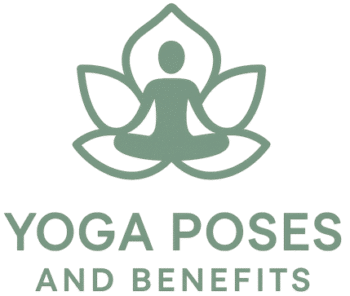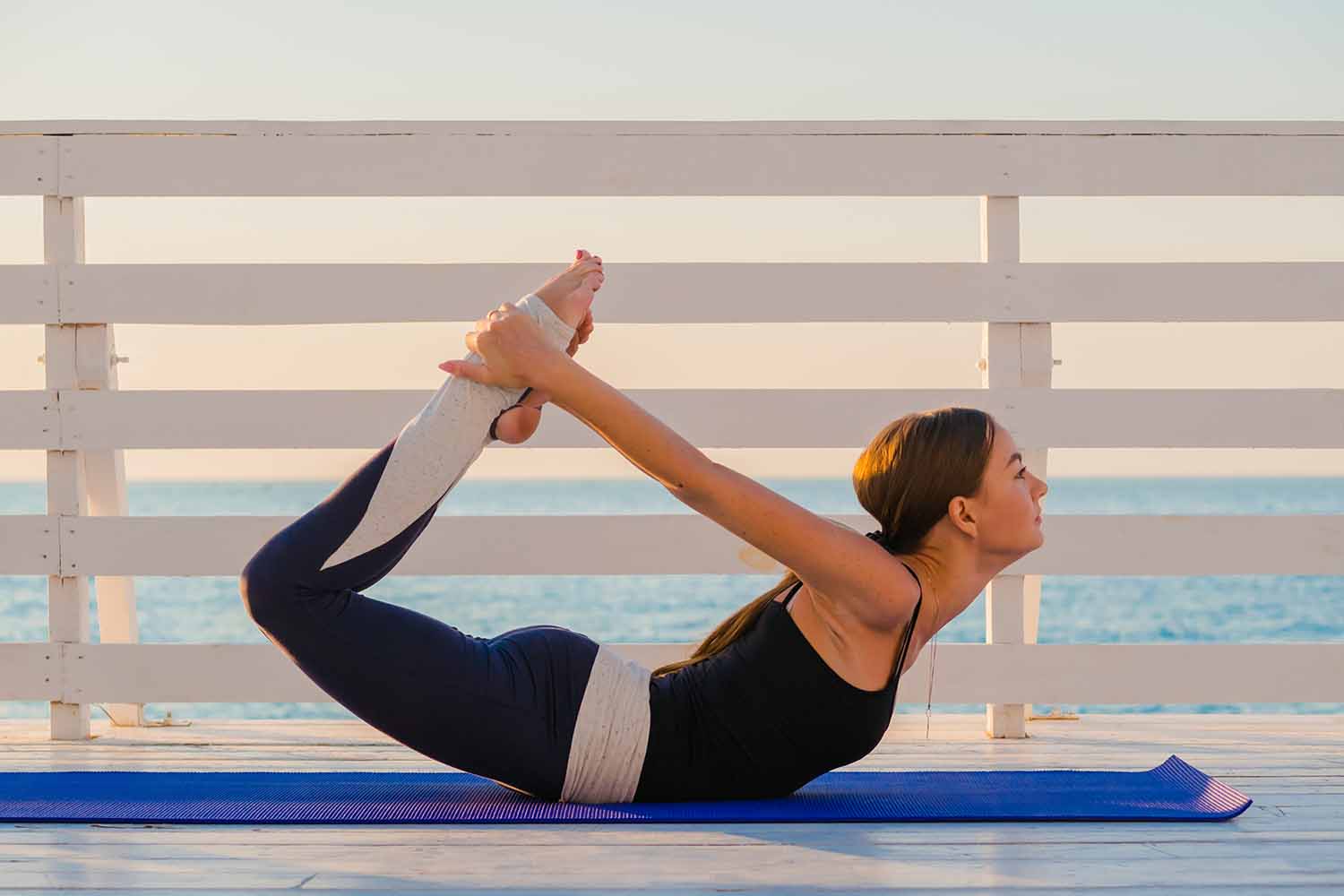Bow Pose in yoga, or Dhanurasana, is a powerful backbend that stretches the chest, shoulders, and thighs while strengthening the back muscles. In this pose, the body takes the shape of a bow, with the arms pulling the legs back to create a deep, heart-opening stretch. Suitable for practitioners at any level, Bow Pose can be adapted to suit different abilities and goals. Whether you are looking to enhance flexibility, build strength, or improve posture, Bow Pose offers a dynamic way to engage both body and mind.
Other Names for Bow Yoga Pose
Known by different names across diverse yoga traditions, Bow Pose is also referred to as:
- Dhanurasana (Sanskrit)
- Arc Pose
- Stringing the Bow Pose
How to do Bow Pose in Yoga
Follow these steps to enter Bow Pose with grace and awareness:
- Start prone: Begin by lying on your stomach with your legs extended and arms resting alongside your body, palms facing up.
- Bend your knees: Inhale as you bend your knees, bringing your heels toward your buttocks.
- Reach back: Reach back with your hands to grasp your ankles. Ensure your knees remain hip-width apart.
- Lift the chest: Exhale as you kick your feet into your hands, lifting your chest and thighs off the mat.
- Create a bow shape: As you kick and lift, your body forms a bow shape, with your heart lifting toward the sky.
- Gaze forward: Keep your gaze forward to maintain balance and alignment.
- Hold the pose: Hold Bow Pose for 15-30 seconds, breathing deeply and steadily.
- Release with care: Exhale as you gently release your ankles, lowering your chest and thighs back down to the mat.
Variations of Bow Yoga Pose
Explore these variations to add depth and diversity to your Bow Pose:
- One-Legged Bow: Lift and kick one leg at a time, alternating between legs.
- Side Bow: Extend one arm forward while reaching the opposite leg back, creating a side-bending variation.
Modifications for Bow Yoga Pose
For a more accessible experience, consider these modifications:
- Half Bow Pose: Lift and kick one leg at a time, focusing on balance and engagement.
- Using a Strap: If reaching your ankles is challenging, use a yoga strap looped around your ankles to facilitate the connection.
Contraindications for Bow Pose in Yoga
While Bow Pose is generally safe for most practitioners, individuals with the following conditions should approach the pose mindfully:
- Recent Abdominal Surgery: Consult with a healthcare professional before attempting Bow Pose.
- Neck or Back Issues: Individuals with chronic neck or back issues should approach the pose with caution and may opt for modifications.
Tips to Improve Bow Yoga Pose in Your Practice
- Equal Kick: Focus on kicking both feet into your hands with equal intensity to maintain balance.
- Lift the Heart: Prioritize lifting the chest toward the sky to deepen the backbend.
- Engage the Quadriceps: Activate the quadriceps to facilitate the lifting of the thighs.
What Muscles Does Bow Pose Work?
Bow Pose engages various muscle groups, including:
- Erector Spinae: Activated to lift and extend the spine.
- Quadriceps: Engaged to lift and support the thighs.
- Deltoids and Rhomboids: Involved in lifting and opening the chest.
Mental and Emotional Benefits of Bow Pose in Yoga?
Beyond its physical impact, Bow Pose offers mental and emotional advantages:
- Heart Opening: The pose creates a profound heart-opening experience, fostering a sense of vulnerability and receptivity.
- Energy Flow: Bow Pose is believed to stimulate the flow of energy, awakening the body and mind.
Is Bow Yoga Pose Suitable for Beginners?
While challenging, Bow Pose is accessible for beginners, offering an opportunity to build back strength and flexibility.
Is Bow Yoga Pose Suitable for Advanced Practitioners?
Advanced practitioners can deepen the pose by exploring variations and extending the duration in the posture.
How Does Bow Pose Contribute to a Yoga Sequence or Flow?
Bow Pose seamlessly integrates into a yoga sequence in the following ways:
- Backbend Series: Incorporated into a backbend series to progressively open and strengthen the spine.
- Heart-Opening Flow: Part of sequences that focus on heart-opening poses, creating a harmonious flow of energy.
How Can I Deepen My Practice in Bow Pose?
Deepening your practice in Bow Pose involves:
- Consistent Practice: Regularly include Bow Pose in your practice to build strength and flexibility.
- Exploring Variations: Gradually explore different variations of Bow Pose, such as One-Legged Bow or Side Bow.
- Breath Awareness: Cultivate awareness of your breath, ensuring a steady and rhythmic breath throughout the pose.
Common Mistakes in Teaching Bow Yoga Pose
To ensure a safe and effective practice, avoid these common teaching mistakes when guiding students in Bow Pose:
- Overlooking Quadriceps Engagement: Emphasize the importance of engaging the quadriceps to facilitate the lift of the thighs.
- Neglecting Balance: Encourage students to find balance by kicking equally with both feet.
- Forgetting Breath Guidance: Remind practitioners to maintain deep and steady breathing, especially as Bow Pose challenges the respiratory system.
In conclusion, Bow Pose stands as an emblem of surrender and strength, inviting practitioners to bow to their own resilience and embrace vulnerability. As you arch into this heart-opening posture, let the bowstring of your body resonate with the harmonious energy within. Whether you’re just beginning your yoga journey or have been practicing for years, Bow Pose invites you to bend, lift, and embody the graceful archer within. Inhale deeply, arch higher, and let the transformative power of Dhanurasana unfold.
What is a Bow Pose good for?
Bow Pose is good for improving spinal flexibility, strengthening the back muscles, and opening the chest and shoulders. As a core backbend in yoga, it stimulates the adrenal glands, stretches the hip flexors, and enhances posture. Commonly practiced in Hatha Yoga and Ashtanga Yoga, it’s also supported by yoga mats and blocks for alignment.
How to do a Bow Pose for beginners?
To do a Bow Pose for beginners, lie face down on a yoga mat, bend your knees, and reach back to hold your ankles with your hands. Inhale and lift your chest and thighs off the mat, forming a bow shape. Use props like yoga straps if flexibility is limited. Focus on even breathing and avoid straining the lower back.
Why is the Bow Pose so difficult?
The Bow Pose is difficult because it requires a combination of spinal flexibility, shoulder mobility, and core strength. This backbend, known in yoga as Dhanurasana, engages the quadriceps, hip flexors, and chest muscles while demanding balance and body awareness, making it challenging for many practitioners.
How long should you hold a Bow Pose?
You should hold Bow Pose (Dhanurasana) for 20 to 30 seconds, focusing on steady breathing and proper alignment. This duration helps stretch the hip flexors, chest, and spine while strengthening back muscles. Common in Hatha and Vinyasa yoga, it’s important to avoid strain and use a yoga mat for support.
How to prep for a Bow Pose?
To prep for a Bow Pose, begin with stretches that open the chest, hip flexors, and quadriceps—such as Cobra Pose, Bridge Pose, and Low Lunge. Engage in gentle backbends to warm up the spine and focus on controlled breathing to improve flexibility and stability in Dhanurasana.
How to modify a Bow Pose?
To modify a Bow Pose, or Dhanurasana, use a yoga strap around the ankles if reaching the feet is difficult, and place a folded blanket under the hips for added support. These props help reduce strain while maintaining the benefits of spinal extension and chest opening.
Who should avoid Bow Pose?
People with back injuries, hernias, high blood pressure, or recent abdominal surgery should avoid Bow Pose. This yoga posture, also known as Dhanurasana, places significant strain on the spine and core. Consulting a certified yoga instructor or physical therapist is recommended before attempting Bow Pose.

